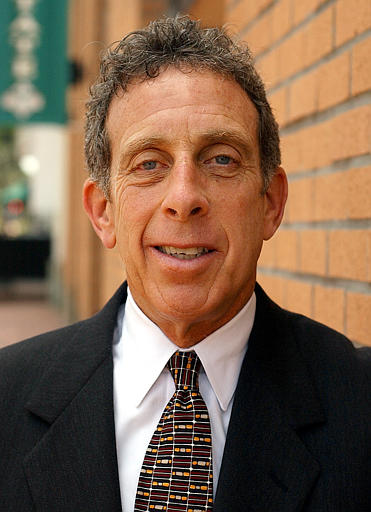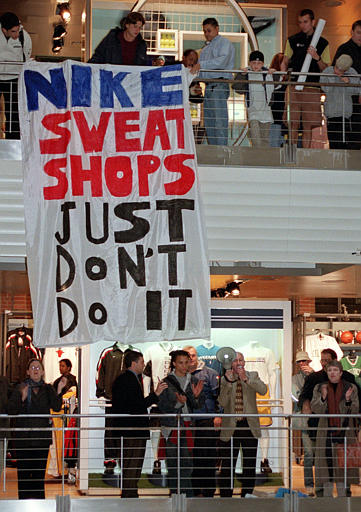The Supreme Court decision in Nike v. Kasky, 539 U.S. 654 (2003), is controversial because it raised, but did not resolve, contemporary issues regarding First Amendment protection for corporate speech in matters of public concern. These unresolved issues remain the focus of a lively discussion among First Amendment scholars.
Nike claimed misleading statements were noncommercial speech
Nike manufactures footwear and apparel in factories in foreign countries. In the 1990s, numerous critics accused Nike of unfair labor practices and unsafe working conditions. Nike responded to these allegations with a public relations and advertising campaign. In 1998 Marc Kasky, an activist lawyer, invoked California’s False Advertising Law and Unfair Competition Law for the purpose of suing Nike for publishing false and misleading statements in this campaign. Nike claimed that the statements were noncommercial speech on matters of public concern and thus were constitutionally protected. Nike prevailed in trial court and in the California Court of Appeals. However, the California Supreme Court reversed the lower courts in its 4-3 decision in Kasky v. Nike, Inc. (2002).
Case was settled out of court without rulings on constitutional issues
In Nike v. Kasky, the U.S. Supreme Court agreed to hear the appeal, then abruptly dismissed it as “improvidently granted,” effectively returning the issue to the California courts for disposition. The case was settled out of court eventually, without any substantive ruling on the constitutional issues.
Justices disagreed on whether the Court need to look into the free speech issues
Justice John Paul Stevens said in a concurring opinion that the Nike case “presents novel First Amendment questions because the speech at issue represents a blending of commercial speech and debate on issues of public importance,” but he also said that the Court did not need to look into the complicated free speech issues at this point.
Three justices dissented, believing that the justices should examine the underlying constitutional issues. Justice Stephen G. Breyer wrote a strong dissent focusing on the importance and need for resolution of the constitutional issues, especially the chilling effects imposed on free speech by the California Supreme Court’s decision.

Because Nike and Kasky settled out of court, at least two significant constitutional issues remain unresolved. The case raises additional questions regarding the vitality of the Central Hudson test for commercial speech in the 21st century. In this photo, activist Marc Kasky poses after an interview in downtown San Diego Thursday, June 26, 2003. (AP Photo/Denis Poroy, used with permission from the Associated Press)
Majority said Nike’s campaign was commercial speech
The clash between the majority and dissenting justices focused on the classification of communication in which Nike was engaged and the free speech implications of that classification. The majority held that Nike’s campaign constituted commercial speech and therefore merited protection only if it satisfied the test in Central Hudson Gas and Electric Corp. v. Public Service Commission (1980). The initial prong of the Central Hudson test — the expression of commercial speech concerns lawful activity and is not misleading — was met because both parties stipulated that the campaign included deceptive statements. The majority held that “communication more likely to deceive the public than to inform it” fails to meet the threshold of commercial communications eligible for constitutional protection.
The dissenters claimed that the speech dealt with an important public issue and therefore merited a high level of protection and that to punish Nike for factual errors would chill corporate participation in future debates on public issues.
Significant constitutional issues remain unresolved
Because Nike and Kasky settled out of court, at least two significant constitutional issues remain unresolved. First, the definition of commercial speech articulated in Kasky v. Nike highlights, but does not dispose of, important questions regarding corporate speech that contains both commercial and noncommercial elements.
Second, the California Supreme Court’s invocation of the threshold part of the Central Hudson test as a threshold determinant of constitutional protection appears to privilege the classification of speech as commercial or noncommercial, at the expense of an inquiry into the functions of corporate communications in contemporary society.
The case raises additional questions regarding the vitality of the Central Hudson test for commercial speech in the 21st century.
This article was originally published in 2009. Richard A. “Tony” Parker is an Emeritus Professor of Speech Communication at Northern Arizona University. He is the editor of Speech on Trial: Communication Perspectives On Landmark Supreme Court Decisions which received the Franklyn S. Haiman Award for Distinguished Scholarship in Freedom of Expression from the National Communication Association in 1994.

